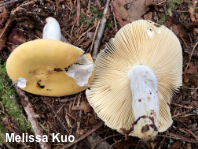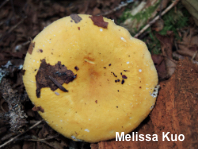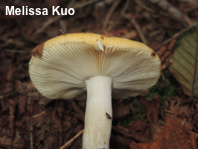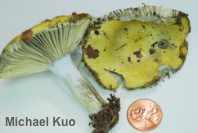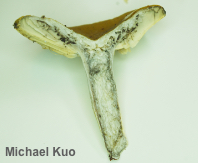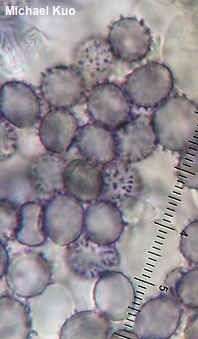| Major Groups > Gilled Mushrooms > Pale-Spored > Russula > Russula claroflava |

|
Russula claroflava [ Basidiomycota > Russulales > Russulaceae > Russula . . . ] by Michael Kuo Russula claroflava is a denizen of birch-based boreal and montane forests in Europe, characterized by its yellow cap, gray staining surfaces, mild taste, and yellow spore print. By current definitions (meaning Bills and Miller 1984, which is not really so current) the species "has a circumboreal distribution," placing it in North America, where "[p]opulations extend into the higher elevations of the Southern Appalachians." Whether or not contemporary, DNA-based study of North American collections would arrive at the same conclusion is anyone's guess. At any rate it is the North American version—in fact, the high-elevation Appalachian version—of Russula claroflava that I'm describing here. While European treatments insist on an association with birch, Bills and Miller suggest that the Appalachian version also associates with red spruce and Fraser fir; the mushrooms featured here were associated with red spruce at elevation of about 6600 feet. Russula flava is a synonym. Description: Ecology: Mycorrhizal with various species of birch, and with red spruce and Fraser fir; growing scattered or gregariously; summer and fall; northern and montane Europe and North America. The illustrated and described collection is from North Carolina. Cap: 3–6 cm; convex when young; becoming broadly convex or nearly flat; tacky to sticky when fresh and young, but soon dry; medium yellow; with age staining gray near the margin; the margin becoming slightly lined; the skin peeling easily about halfway to the center. Gills: Narrowly attached to the stem; close; without short-gills; white when young but soon becoming yellow as the spores mature; discoloring gray with age. Stem: 3–6 cm long; 1–1.5 cm thick; equal; dry; bald; white, bruising and discoloring gray; hollowing with age; basal mycelium white. Flesh: White; staining and aging slowly gray. Odor and Taste: Not distinctive. Chemical Reactions: KOH negative on cap surface. Iron salts negative or slightly pink on stem surface. Spore Print: Orangish yellow. Microscopic Features: Spores 7–10 x 6–9 µm; subglobose or broadly ellipsoid; ornamentation 0.5–1 µm high, as mostly isolated amyloid warts and occasional connecting lines. Macrocystidia 25–40 x 5–10 µm; fusiform, occasionally with a mucro; smooth; thin-walled; yellowish in KOH. Pileipellis an ixocutis; elements 2–5 µm wide, hyaline and smooth in KOH; primordial hyphae present, often encrusted. REFERENCES: Grove, 1888. (Burlingham, 1915; Kauffman, 1918; Smith, Smith & Weber, 1979; Phillips, 1981; Bills & Miller, 1984; Arora, 1986; Kibby & Fato, 1990; Phillips, 1991/2005; Schalkwijk-Barendsen, 1991; Lincoff, 1992; Barron, 1999; Kränzlin, 2005; Kibby, 2006; McNeil, 2006; Miller & Miller, 2006; Buczacki et al., 2012; Kuo, 2007; Baroni, 2017; Cabon et al., 2017; Knudsen et al., 2018.) Herb. Kuo 08121902. This site contains no information about the edibility or toxicity of mushrooms. |
© MushroomExpert.Com |
|
Cite this page as: Kuo, M. (2019, November). Russula claroflava. Retrieved from the MushroomExpert.Com Web site: http://www.mushroomexpert.com/russula_claroflava.html |
